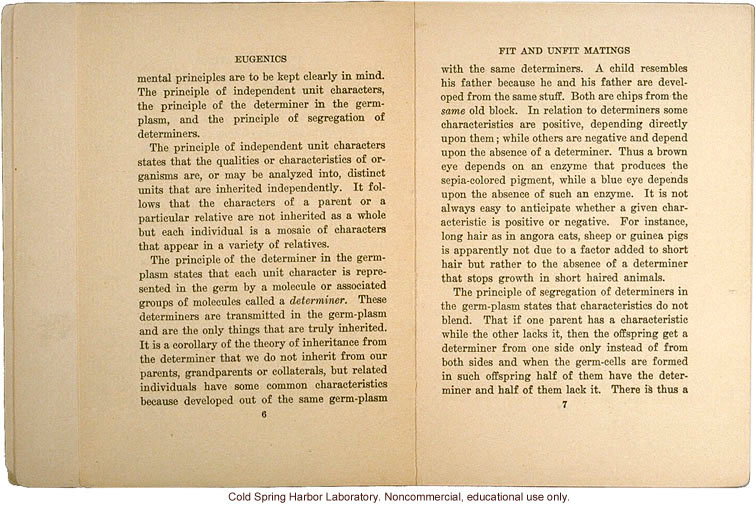[left side]
Eugenics
mental principles are to be kept clearly in mind. The principle of independent unit characters, the principle of the determiner in the germ-plasm, and the principle of segregation of determiners.
The principle of independent unit characters states that the qualities or characteristics of organisms are, or may be analyzed into, distinct units that are inherited independently. It follows that the characters of a parent or a particular relative are not inherited as a whole but each individual is a mosaic of characters that appear in a variety of relatives.
The principle of the determiner in the germ-plasm states that each unit character is represented in the germ by a molecule or associated groups of molecules called a [italics]determiner[end italics]. These determiners are transmitted in the germ-plasm and are the only things that are truly inherited. It is a corollary of the theory of inheritance from the determiner that we do not inherit from our parents, grandparents, or collaterals, but related individuals have some common characteristics because developed out of the germ-plasm
6
[right side]
Fit and Unfit Matings
with the same determiners. A child resembles his father because he and his father are developed from the same stuff. Both are chips from the [italics]same[end italics] old block. In relation to determiners some characteristics are positive, depending directly upon them; while others are negative and depend upon the absence of the determiner. Thus a brown eye depends on an enzyme that produces a sepia-colored pigment, while a blue eye depends upon the absence of such an enzyme. It is not always easy to anticipate whether a given characteristic is positive or negative. For instance, long hair as in angora cats, sheep or guinea pigs is apparently not due to a factor added to short hair but rather to the absence of a determiner that stops growth in short haired animals.
The principle of segregation of determiners in the germ-plasm states that characteristics do not blend. That if one parent has a characteristic while the other lacks it, then the offspring get a determiner from one side only instead of from both sides ad when the germ-cells are formed in such offspring half of them have the determiner and half of them lack it. There is thus a
7
[end]


